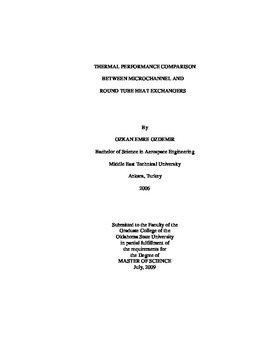| dc.contributor.advisor | Cremaschi, Lorenzo | |
| dc.contributor.author | Ozdemir, Ozkan Emre | |
| dc.date.accessioned | 2014-04-17T19:53:28Z | |
| dc.date.available | 2014-04-17T19:53:28Z | |
| dc.date.issued | 2009-07-01 | |
| dc.identifier.uri | https://hdl.handle.net/11244/10015 | |
| dc.description.abstract | Alternative round tube profiles to straight microchannel (SMC) tube geometry was explored by gradually applying the microchannel features to fin and tube type heat exchangers. First, previous experimental and computational works related to design and heat transfer analysis of microchannel heat exchanger tubes and testing was reviewed and then a numerical CFD model in FLUENT solver was developed, which was experimentally validated within an error range of 0.1 to 7.8 % based on available data in literature. Single phase, water to water, laminar, counter fluid flow of tube in shell calorimeter heat transfer experiments were numerically simulated to analyze the refrigerant side heat transfer enhancement if round microchannel tubes are used as outdoor coil. According to numerical results, the refrigerant side heat transfer capacity of round tubes of 10.3mm outer diameter with 42 microports of about 0.6 mm port diameter distributed around the tube perimeter (round tube microchannel) was estimated to be about 24% higher than conventional round tube (with no microchannel ports in them) and about 15% lower than conventional straight microchannel tube heat exchangers used in outdoor evaporators. In addition to refrigerant side, parametric studies were performed to investigate the heat transfer effectiveness of 10.3 mm and 5.15 mm outer diameter round (microchannel) tubes (multi port and annular) under cross flow configuration with dry air streams and results were compared with straight microchannel tubes in terms of tube diameter tube spacing effect. It was obtained that the round tube design of 5.15 mm outer diameter having an annular port of 1.6mm hydraulic diameter within 11mm edge to edge tube spacing of vertically parallel fin and tube coil configuration can provide similar air side heat transfer capacity of straight microchannel coil based on its secondary heat transfer area. Additionally, this configuration can provide 50 % better pressure drop performance compared to conventional straight microchannel tube coil. | |
| dc.format | application/pdf | |
| dc.language | en_US | |
| dc.publisher | Oklahoma State University | |
| dc.rights | Copyright is held by the author who has granted the Oklahoma State University Library the non-exclusive right to share this material in its institutional repository. Contact Digital Library Services at lib-dls@okstate.edu or 405-744-9161 for the permission policy on the use, reproduction or distribution of this material. | |
| dc.title | Thermal performance comparison between microchannel and round tube heat exchangers | |
| dc.type | text | |
| dc.contributor.committeeMember | Fisher, Daniel | |
| dc.contributor.committeeMember | Lilley, David | |
| osu.filename | OZDEMIR_okstate_0664M_10369.pdf | |
| osu.college | Engineering, Architecture, and Technology | |
| osu.accesstype | Open Access | |
| dc.description.department | Mechanical & Aerospace Engineering | |
| dc.type.genre | Thesis | |
